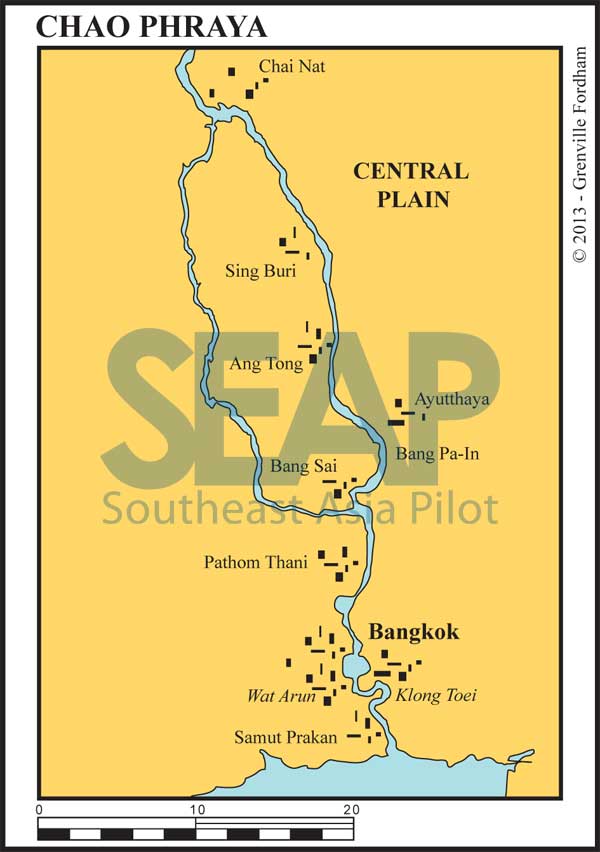

From Samut Prakan to Bangkok (30 nm), the river is wide and from 7-15 metres deep. Tidal currents run at up to two knots. No hazards threaten, apart from floating plastic bags and large floating islands of water hyacinths.
Read moreSeveral jetties along both sides offer fuel and water. Beware of submerged piles around the jetties. Manoeuvre with caution. Khlong Toey, Bangkok’s commercial harbour along the banks of the river, has no facilities for yachts or small ships.
The first bridge, Rama IX Bridge (Saphan Phra Ram 9), is high enough for cargo ships. The second, the Bangkok Bridge (Saphan Krungthep), is about five metres high and used to open for shipping until another fixed bridge was built alongside. These bridges are the last negotiable by boats with air clearance greater than four metres.
Two shipyards are available for small ship repairs: Banglampoo Lang Shipyard and the Wang Chao Shipyard. Tridhos City Marina has marina and dry dock facilities for yachts up to 36 feet. Near the mouth of the river on the east bank is the Italthai Shipyard, which has superyacht lifting and refit facilities. The best area to moor a motor yacht, while visiting Bangkok, is on the west bank between the Bangkok and Sathorn (Taksin) bridges.
Some of Bangkok’s most famous landmarks are right on the river. Between Sathorn and Krung Thon bridges, for example, you’ll find the Grand Palace, the Temple of Dawn, the Royal Barge Museum, the Oriental Hotel, Shangri-la Hotel and more.
An exploration of the canal network, mostly on the Thonburi (west) side of the river, makes an especially memorable excursion. Longtail boats, rented by the hour, can be chartered at the jetties around the big hotels.
Allow at least 2-3 hours for a wide-ranging tour. Be prepared to bargain. And if you don’t want to be dropped off at tourist souvenir shops, tell the boat driver in advance.
Ayutthaya, the capital of Siam’s ancient Kingdom, is one of the most fascinating archaeological sites in Thailand. Going upriver is an unforgettable experience. The broad Chao Phraya is deep and easily navigable, its banks mostly clear.
Traditional houses on stilts house people pursuing a lifestyle little changed over the centuries.
Read moreMost Buddhist temples are happy to welcome a visiting yacht for the night. Indeed, you’re likely to become the chief attraction of the local village.
Water is readily available, and basic Thai food can be found in the markets of Pathum Thani, Bang Pa-In and Ayutthaya.
Above Ayutthaya, the Chao Phraya River is no longer subject to tidal currents, and is purely fresh water. The river is regulated by the dam at Chai Nat, some 120 kilometres upstream; the 2-3 knot current allows for pleasant navigation.
Giant shade trees, sounds of gongs from fantastic temples appearing every 500 metres or so, houses on stilts with small wooden jetties from which children swim in the river, little wooden sampans selling bananas – it’s a trip back in time.
The city of Ang Thong is the most convenient for food supplies, but provisions are also available from the markets of Singburi and Inburi.
From Inburi to Chai Nat Dam, the banks are steep. Watch out for sandbanks, especially in the dry season (March to May). Fortunately, a good navigation aid in the form of a series of black buoys is available.
Avoid leaving the channel, not more than 3 metres deep at some points. The temples along this stretch are inaccessible, since the river is 5-6 metres below its natural banking, and no overnight stop is possible.
The lock to the Chai Nat Dam is on the east bank and makes a potential stop for the night. Chai Nat town is some 3 kilometres farther along. There are local taxis and small restaurants at the dam.
Note that this website may not reflect the most recent updates to the printed book and the eBook. While every effort has been made to ensure that the information contained in this book is accurate, the charts of anchorages are based on personal experience and satellite imagery and are intended as a guide only. They should not be used for navigation. Please refer to Official Hydrographic Charts of the respective countries.
Copyright.
The copyright holders of all content, in print and digital editions, are: Published book © Phuket Publicity Services Ltd. Part. / Texts © Bill O’Leary & Grenville Fordham / Design, layout & charts © Grenville Fordham / Photography: © as indicated in photo credits. All rights reserved
No part of this publication may be reproduced, stored, or transmitted in any form or by any means - graphic, electronic or mechanical, including photocopying, recording or otherwise – without the express permission of the publisher, Phuket Publicity Services Limited Partnership, and the other copyright owners.

This website uses cookies to improve your experience. We believe you'll be OK with this, but you can opt-out if you wish. Or you can go to 'cookie settings' and choose which cookies to allow. Privacy policy
